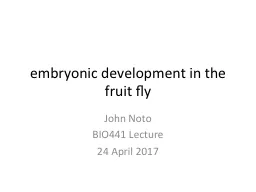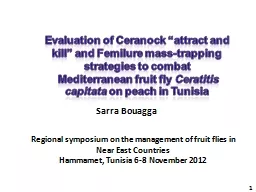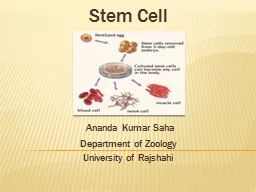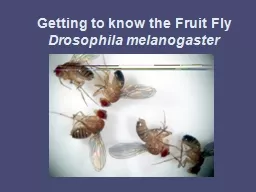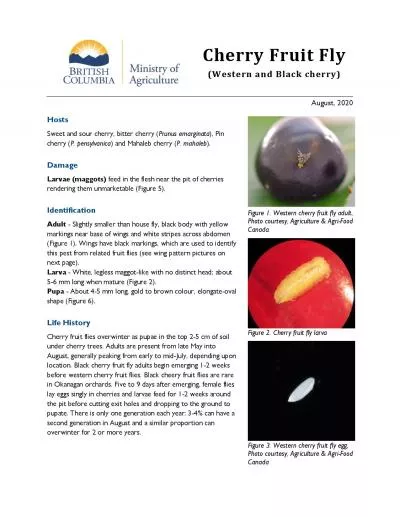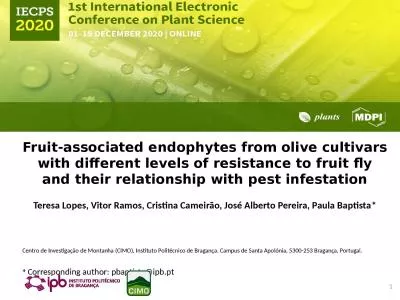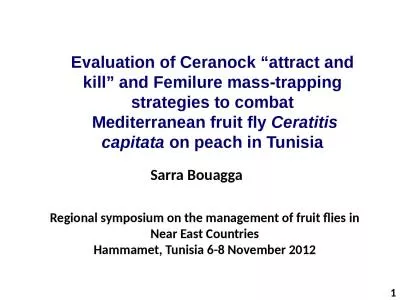PPT-embryonic development in the fruit fly
Author : tawny-fly | Published Date : 2017-10-05
John Noto BIO441 Lecture 24 April 2017 Development Development refers to interaction of the genome with the cytoplasm and external environment to produce a programmed
Presentation Embed Code
Download Presentation
Download Presentation The PPT/PDF document "embryonic development in the fruit fly" is the property of its rightful owner. Permission is granted to download and print the materials on this website for personal, non-commercial use only, and to display it on your personal computer provided you do not modify the materials and that you retain all copyright notices contained in the materials. By downloading content from our website, you accept the terms of this agreement.
embryonic development in the fruit fly: Transcript
John Noto BIO441 Lecture 24 April 2017 Development Development refers to interaction of the genome with the cytoplasm and external environment to produce a programmed sequence of typically irreversible events. An embryo is a . multicellular. . eukaryotic. organism in its early stages of development. In humans, an embryo is carried in the uterus.. I. n humans, the embryo is a developing organism until the first eight weeks, after which it is called a fetus until birth. . Challenge of genetic control. It’s long been known that who we are depends in part on our environment and in part on our parents. This old and familiar idea was given greater . clarity . and precision with the discovery of DNA as the chemical basis of . Ceranock. “attract and kill” and . Femilure. mass-trapping strategies to combat. M. editerranean fruit fly . Ceratitis capitata . on peach . in Tunisia. Sarra. . Bouagga. Regional symposium on the management of fruit flies in Near East Countries. Voluntary regulation of the number of children produced and when they are conceived.. Coitus interrupts: withdrawal of the penis from the vagina before ejaculation.. Rhythm method: abstinence from sexual intercourse for several days before and after ovulation.. Definition of Extra Embryonic Membrane:. The blastoderm . . in birds , reptiles and mammals not only gives rise to embryo, but also to certain structures that lie outside the embryo. These extra embryonic structures are called Extra Embryonic Membrane.. Saha. Department. of Zoology. University. of . Rajshahi. What is stem cell?. An undifferentiated cell of a . multicellular. organism which is capable of giving rise to indefinitely more cells of the same type, and from which certain other kinds of cell arise by differentiation.. Developmental stages of humans. Fertilization. Zygote. It is a fertilized . egg . Diploid (2n). Female . pronuclei. Male . pronuclei. Amphimixis. Developmental stages of humans. Zona. . pellucida. Surrounds the zygote. Explain prenatal development from fertilization to birth. Understand different biological process’ in all phases of prenatal development. Define key vocabulary. Chart different phases in . somitogenesis. I'll fly away in the morning. When I die Hallelujah by and by. I'll fly away. Some bright morning . when this life is over. I'll fly away. To a land on . God's celestial shore. I'll fly away. I'll fly away, O glory. Drosophila . melanogaster. Drosophila Melanogaster, a popular genetic model organism. ~ 50% of fly genes have vertebrate homologs. Small and easy to grow in lab. Short generation time . Produce high amounts of offspring. 2020 Emergency Response Triggers i Delimitation Duration of Delimitation ii generations for singlefly detections) Eradication iii iv Mated female of any genus and species of fruit fly presumed or k (Western and Black cherry) August , 20 20 Hosts Sweet and sour cherry, bitter cherry ( Prunus emarginata ), Pin cherry ( P. pensylvanica ) and Mahaleb cherry ( P. mahaleb ) . Damage Larvae (maggots Teresa Lopes, . Vitor. Ramos, Cristina . Cameirão. , José Alberto Pereira, Paula Baptista. *. Centro de . Investigação. de . Montanha. (CIMO), . Instituto. . Politécnico. de . Bragança. . Campus de Santa . “attract and kill” and . Femilure. mass-trapping strategies to combat. M. editerranean fruit fly . Ceratitis capitata . on peach . in Tunisia. Sarra. . Bouagga. Regional symposium on the management of fruit flies in Near East Countries.
Download Document
Here is the link to download the presentation.
"embryonic development in the fruit fly"The content belongs to its owner. You may download and print it for personal use, without modification, and keep all copyright notices. By downloading, you agree to these terms.
Related Documents

